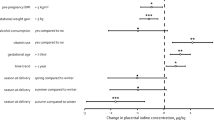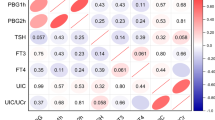Abstract
Placental type 3 iodothyronine deiodinase (D3) potentially protects the fetus from the elevated maternal thyroid hormones. Na+/I− symporter (NIS) is a plasma membrane glycoprotein, which mediates active iodide uptake. Our objectives were to establish the distribution of NIS and D3 gene expressions in the placenta and the amniotic membrane and to investigate the relationship between placental D3 and NIS gene expressions and maternal iodine, selenium, and thyroid hormone status. Thyroid hormones, urinary iodine concentration (UIC), and selenium levels were measured in 49 healthy term pregnant women. NIS and D3 gene expressions were studied with the total mRNA RT-PCR method in tissues from maternal placenta (n = 49), fetal placenta (n = 9), and amniotic membrane (n = 9). NIS and D3 gene expressions were shown in the fetal and maternal sides of the placenta and amniotic membrane. Mean blood selenium level was 66 ± 26.5 μg/l, and median UIC was 143 μg/l. We could not demonstrate any statistically significant relationship of spot UIC and blood selenium with NIS and D3 expression (p > 0.05). Positive correlations were found between NIS and thyroxine-binding globulin (TBG) (r = 0.3, p = 0.042) and between D3 and preoperative glucose levels (r = 0.4, p = 0.006). D3 and NIS genes are expressed in term placenta and amniotic membrane; thus, in addition to placenta, amniotic membrane contributes to regulation of maternofetal iodine and thyroid hormone transmission. Further studies are needed to clarify the relationship between maternal glucose levels and placental D3 expression and between TBG and placental NIS expression.


Similar content being viewed by others
References
St Germain DL, Galton VA, Hernandez A (2009) Minireview: Defining the roles of the iodothyronine deiodinases: current concepts and challenges. Endocrinology 150:1097–1107
Li H, Richard K, McKinnon B, Mortimer RH (2007) Effect of iodide on human choriogonadotropin, sodium-iodide symporter expression, and iodide uptake in BeWo choriocarcinoma cells. J Clin Endocrinol Metab 92:4046–4051
Tazebay UH, Wapnir IL, Levy O, Dohan O, Zuckier LS, Zhao QH, Deng HF, Amenta PS, Fineberg S, Pestell RG, Carrasco N (2000) The mammary gland iodide transporter is expressed during lactation and in breast cancer. Nat Med 6:871–878
Riedel C, Dohan O, De la Vieja A, Ginter CS, Carrasco N (2001) Journey of the iodide transporter NIS: from its molecular identification to its clinical role in cancer. Trends Biochem Sci 26:490–496
Bizhanova A, Kopp P (2009) Minireview: The sodium-iodide symporter NIS and pendrin in iodide homeostasis of the thyroid. Endocrinology 150:1084–1090
Di Cosmo C, Fanelli G, Tonacchera M, Ferrarini E, Dimida A, Agretti P, De Marco G, Vitti P, Pinchera A, Bevilacqua G, Naccarato AG, Viacava P (2006) The sodium-iodide symporter expression in placental tissue at different gestational age: an immunohistochemical study. Clin Endocrinol (Oxf) 65:544–548
Bidart JM, Lacroix L, Evain-Brion D, Caillou B, Lazar V, Frydman R, Bellet D, Filetti S, Schlumberger M (2000) Expression of Na+/I− symporter and Pendred syndrome genes in trophoblast cells. J Clin Endocrinol Metab 85:4367–4472
Riedel C, Levy O, Carrasco N (2001) Post-transcriptional regulation of the sodium/iodide symporter by thyrotropin. J Biol Chem 15:21458–21463
Schroder-van der Elst JP, van der Heide D, Kastelijn J, Rousset B, Obregon MJ (2001) The expression of the sodium/iodide symporter is up-regulated in the thyroid of fetuses of iodine-deficient rats. Endocrinology 142:3736–3741
Carvalho DP (2003) Modulation of uterine iodothyronine deiodinases—a critical event for fetal development? Endocrinology 144:4250–4252
Galton VA, Martinez E, Hernandez A, St Germain EA, Bates JM, St Germain DL (1999) Pregnant rat uterus expresses high levels of the type 3 iodothyronine deiodinase. J Clin Invest 103:979–987
Mortimer R, Galligan JP, Cannell GR, Addison RS, Roberts MS (1996) Maternal to fetal thyroxine transmission in the human term placenta is limited by inner ring deiodination. J Clin Endocrinol Metab 81:2247–2249
Huang SA, Dorfman DM, Genest DR, Salvatore D, Larsen PR (2003) Type 3 iodothyronine deiodinase is highly expressed in the human uteroplacental unit and in fetal epithelium. J Clin Endocrinol Metab 88:1384–1388
Wasco EC, Martinez E, Grant KS, St Germain EA, St Germain DL, Galton VA (2003) Determinants of iodothyronine deiodinase activities in rodent uterus. Endocrinology 144:4253–4261
Kester MH, Kuiper GG, Versteeg R, Visser TJ (2006) Regulation of type III iodothyronine deiodinase expression in human cell lines. Endocrinology 147:5845–5854
Bates JM, Spate VL, Morris JS, St Germain DL, Galton VA (2000) Effects of selenium deficiency on tissue selenium content, deiodinase activity, and thyroid hormone economy in the rat during development. Endocrinology 141:2490–2500
Chanoine JP, Alex S, Stone S, Fang SL, Veronikis I, Leonard JL, Braverman LE (1993) Placental 5-deiodinase activity and fetal thyroid hormone economy are unaffected by selenium deficiency in the rat. Pediatr Res 34:288–292
Knudsen N, Bols B, Bülow I, Jørgensen T, Perrild H, Ovesen L, Laurberg P (1999) Validation of ultrasonography of the thyroid gland for epidemiological purposes. Thyroid 9:1069–1074
Stagnaro-Green A, Abalovich M, Alexander E, Azizi F, Mestman J, Negro R, Nixon A, Pearce EN, Soldin OP, Sullivan S, Wiersinga W (2011) Guidelines of the American Thyroid Association for the diagnosis and management of thyroid disease during pregnancy and postpartum. Thyroid 21:1081–1125
Rayburn WF, Robinson A, Braverman LE, He XM, Pino S, Gargas ML, Kinzell JH (2008) Iodide concentrations in matched maternal serum, cord serum, and amniotic fluid from preterm and term human pregnancies. Reprod Toxicol 25:129–132
García-Fuentes E, Gallo M, García L, Prieto S, Alcaide-Torres J, Santiago P, Velasco I, Soriguer F (2008) Amniotic fluid iodine concentrations do not vary in pregnant women with varying iodine intake. Br J Nutr 99:1178–1181
Roti E, Fang SL, Green K, Braverman LE, Emerson CH (1983) Inner ring deiodination of thyroxine and 3,5,3′-triiodothyronine by human fetal membranes. Am J Obstet Gynecol 147:788–792
Schröder-van der Elst JP, van der Heide D, Morreale de Escobar G, Obregón MJ (1998) Iodothyronine deiodinase activities in fetal rat tissues at several levels of iodine deficiency: a role for the skin in 3,5,3′-triiodothyronine economy? Endocrinology 139:2229–2234
Glinoer D (1997) The regulation of thyroid function in pregnancy: pathways of endocrine adaptation from physiology to pathology. Endocr Rev 18:404–433
Glinoer D (2007) The importance of iodine nutrition during pregnancy. Public Health Nutr 10:1542–1546
Schussler GC (2000) The thyroxine-binding proteins. Thyroid 10:141–149
Ekins RP, Sinha AK, Pickard MR, Evans IM, al Yatama F (1994) Transport of thyroid hormones to target tissues. Acta Med Austriaca 21:26–34
Emerson CH, Bambini G, Alex S, Castro MI, Roti E, Braverman LE (1988) The effect of thyroid dysfunction and fasting on placenta inner ring deiodinase activity in the rat. Endocrinology 122:809–816
Chidakel A, Mentuccia D, Celi FS (2005) Peripheral metabolism of thyroid hormone and glucose homeostasis. Thyroid 15:899–903
Medina MC, Molina J, Gadea Y, Fachado A, Murillo M, Simovic G, Pileggi A, Hernández A, Edlund H, Bianco AC (2011) The thyroid hormone-inactivating type III deiodinase is expressed in mouse and human {beta}-cells and its targeted inactivation impairs insulin secretion. Endocrinology 152:3717–3727
Liberman CS, Pino SC, Fang SL, Braverman LE, Emerson CH (1998) Circulating iodide concentrations during and after pregnancy. J Clin Endocrinol Metab 83:3545–3549
Abalovich M, Amino N, Barbour LA, Cobin RH, De Groot LJ, Glinoer D, Mandel SJ, Stagnaro-Green A (2007) Management of thyroid dysfunction during pregnancy and postpartum: an Endocrine Society Clinical Practice Guideline. J Clin Endocrinol Metab 92:S1–S47
Erdoğan MF, Ağbaht K, Altunsu T, Ozbas S, Yücesan F, Tezel B, Sargın C, Ilbeğ I, Artık N, Köse R, Erdoğan G (2009) Current iodine status in Turkey. J Endocrinol Invest 32:617–622
Ozdemir HS, Karadas F, Pappas AC, Cassey P, Oto G, Tuncer O (2008) The selenium levels of mothers and their neonates using hair, breast milk, meconium, and maternal and umbilical cord blood in Van Basin. Biol Trace Elem Res 122:206–215
Kilinc M, Guven MA, Ezer M, Ertas IE, Coskun A (2008) Evaluation of serum selenium levels in Turkish women with gestational diabetes mellitus, glucose intolerants, and normal controls. Biol Trace Elem Res 123:35–40
Rayman MP (2002) The argument for increasing selenium intake. Proc Nutr Soc 61:203–215
Izquierdo Alvarez S, Castañón SG, Ruata ML, Aragüés EF, Terraz PB, Irazabal YG, González EG, Rodríguez BG (2007) Updating of normal levels of copper, zinc and selenium in serum of pregnant women. J Trace Elem Med Biol 21:49–52
Ramauge M, Pallud S, Esfandiari A, Gavaret J, Lennon A, Pierre M, Courtin F (1996) Evidence that type III iodothyronine deiodinase in rat astrocyte is a selenoprotein. Endocrinology 137:3021–3025
Acknowledgments
This project (106S229/SBAG-3475) was supported by TUBITAK (Scientific and Technical Research Council of Turkey). We gratefully acknowledge Prof. Murat Erdogan for the help in UIC analysis and Elif H. Kamber for the technical assistance of the genetic analysis.
Conflict of Interest
The authors declare that they have no conflict of interest.
Author information
Authors and Affiliations
Corresponding author
Rights and permissions
About this article
Cite this article
Akturk, M., Oruc, A.S., Danisman, N. et al. Na+/I− Symporter and Type 3 Iodothyronine Deiodinase Gene Expression in Amniotic Membrane and Placenta and Its Relationship to Maternal Thyroid Hormones. Biol Trace Elem Res 154, 338–344 (2013). https://doi.org/10.1007/s12011-013-9748-y
Received:
Accepted:
Published:
Issue Date:
DOI: https://doi.org/10.1007/s12011-013-9748-y




